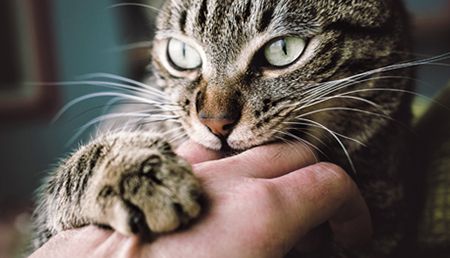Feline behavior quick tips: Get a visual
Two tips learned at Fetch dvm360 conference in San Diego can help fill in the gaps when veterinary clients words dont paint the full picture.

Getty Images
Here are two tips veterinary behaviorists and Fetch dvm360 conference speakers Barbara Sherman, MS, PhD, DVM, DACVB, DACAW, and Lisa Radosta, DVM, DACVB, gave attendees on feline behavior issues at Fetch dvm360 conference in San Diego. Before the initial behavioral consultation, both doctors stress the importance of performing a thorough physical examination and ruling out medical causes of the cat's behavior. Then you can get down to analysis of the behavior, with a referral to a veterinary behaviorist if needed.
In dealing with feline inappropriate elimination, Dr. Sherman says that asking the client to bring in a copy of their home's or apartment's floor plan marked with areas that the cat is eliminating can provide clues to the cause. For example, does it appear that the cat is spraying on vertical surfaces in several areas like the windows and doors to the outside? There may be a new cat in the neighborhood that's been appearing outside the pet owner's home and the resident cat is marking their territory. Seeing where the elimination is happening can give quick clues and a jumping off place, Dr. Sherman says.
During the consultation, Dr. Radosta asks clients to show photos of their cat or cats. While it only shows the behavior in that one moment, you can see the body language at the time. Are there two cats in the photo and one is showing alert, bold behavior and the other is looking away and trying to display avoidance behavior? When a client describes the photo, they may say the cats are angry and calm, respectively, because they don't have the knowledge of behavior to see the subtle things the cats are trying to tell each other, she says.
Video is also an extremely useful tool in seeing the behavior that's happening in the home, because again, clients may not recognize the very subtle things their cat is trying to tell them. For example, the cat may solicit petting but it doesn't want to be pet the way the owner is petting them and then it bites them. Watching the video with the client and explaining what's happening, Dr. Radosta says, can help teach clients the signals and formulate a behavioral plan. Did the cat bunt and like it when the pet owner was petting the side of its face, but then when the pet owner continued to pet down the side of its body, its ears went flat and its pupils dilated? The client may not notice that and think that the cat asked to be pet. Having that visual can go a long way in teaching new behaviors, she says.